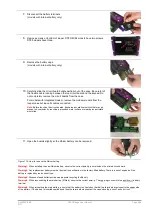
UM-0085-B09
DT80 Range User Manual
Page 269
RG
Command Server Timeout Profile
A command server timeout has been added while fixing the communication issues over TCPIP on poor network
connection. The default value on the Command _Server SESSION_TIMEOUT is zero, which will never disconnect the
connection. Any value can be set in seconds and command server session will end after inactivity for the specific period.
Values marked
time
in the table are specified in a similar way to schedule time intervals – that is, an integer followed by a
unit letter (
D
,
H
,
M
,
S
or
T
for days, hours, minutes, seconds and milliseconds respectively). Values marked
cron-spec
are a "cron" time/date specifier, as described in
.
In the default column,
(*)
indicates that a suitable default value will be set automatically, if possible, based on the mobile
carrier that issued the SIM.
Examples
To set the
DT80
's IP address for the Ethernet port:
PROFILE ETHERNET IP_ADDRESS=192.168.1.225
To set the default date format to North American style:
PROFILE PARAMETERS P31=2
Note
Special characters may be inserted into profile values using
^
x
or
\
nnn
notation, as described in
.
This means that if the profile value requires an actual
\
character then it must be entered twice, e.g.
PROFILE FUNCTION F1_COMMAND="DIR B:\\JOBS
Remember also that if
DeTransfer
is used to send the above line then the backslashes must be doubled again, i.e.
PROFILE FUNCTION F1_COMMAND="DIR B:\\\\JOBS
Setting the System Time
The
DT80
’s real-time clock/calendar is based on a 24-hour clock that has a resolution of approximately 0.1ms. This is
used to timestamp all logged data.
Time and date are maintained when the logger is switched off or reset. If the logger is switched off and the internal
Internal Memory-Backup Battery (P291)
) is removed or discharged, then the date and time
will be reset to 1989/01/01 00:00:00
D and T Channel Types
The
DT80
's time and date can be set using the
T
and
D
internal channel types (
), e.g.:
T=13:05
Time 13:05:00.000
D=1/4/2006
Date 01/04/2006
The time and date must be specified in the current
P39
and
P31
formats. The time can also be set to a CV value, where
the CV value is the number of seconds since midnight. Similarly for the date, except the value is now the number of
seconds since the base date (1/1/1989).
For example, to set the system time forward one hour you could use:
T(=1CV) 1CV(W)=1CV+3600 T=1CV
Time 15:59:23.460
Time 16:59:23.461
Note:
only a single CV can be placed after the "=". Expressions are not supported.
DT Command
Alternatively, the
DT
command can be used to set both date and time. In this case the date/time is specified either in
dataTaker ISO format or ISO8601 format and enclosed in square brackets, e.g.:
DT=[2006/04/01,13:05:00]
or
DT=[2006-04-01T13:05:00]
Time Zone
Depending on the application, you may choose to set the
DT80
's time to either:
•
local time. In this case you may need to alter the time periodically to adjust for daylight saving time, if applicable
•
local standard time. The logger is still set to the local time zone, but no correction is made for daylight saving
time
•
UTC (GMT) time. This may be appropriate if there are a number of
DT80
s (connected to the host computer via
a wide area TCP/IP network, for example) which are in different time zones
The
DT80
and the
dataTaker
host software currently do not provide any specific support for data collected in disparate
time zones – it is therefore up to the user to manage this.
















































